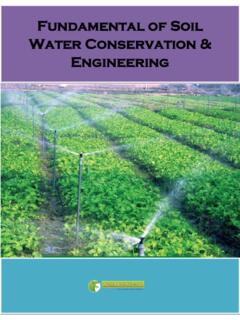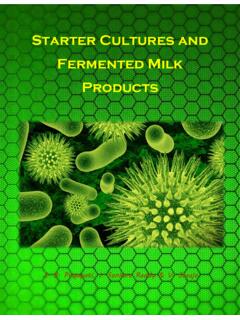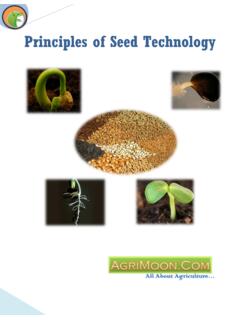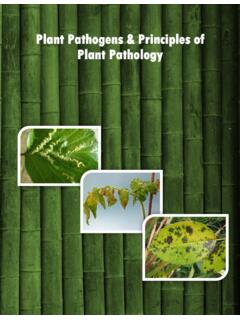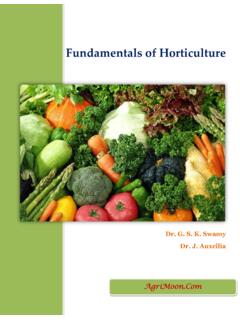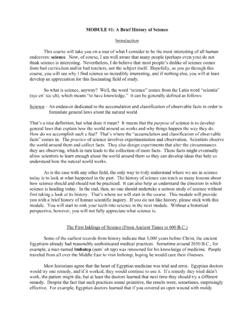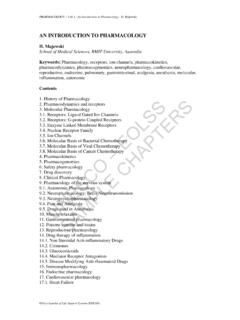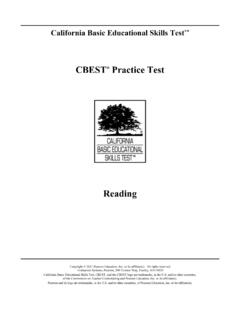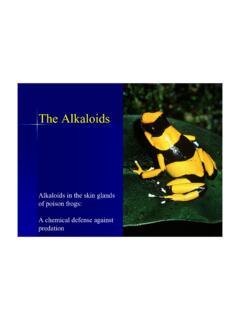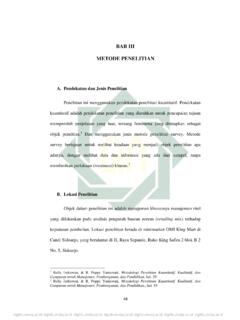Transcription of Medicinal and Aromatic Crops - AgriMoon
1 Medicinal and Aromatic Crops Dr. K. Rajamani Dr. L. Nalina Dr. Laxminarayana HegdeMedicinal and Aromatic Crops Course Creators Dr. K. Rajamani Professor Department of Medicinal & Aromatic Crops Horticultural College & Research Institute TNAU, Coimbatore-3 Dr. L. Nalina Assistant Professor (Hort.) Dept. of Medicinal and Aromatic Crops , Horticultural College & Research Institute TNAU, Coimbatore-3 Course Moderator Dr. Laxminarayana Hegde Associate Professor of Medicinal and Aromatics Kittur Rani Channamma College of Horticulture Arabhavi, Gokak Tq, Belgaum Dist Index 1 History, scope, constraints and opportunities in cultivation of Medicinal and Aromatic plants 5-14 2 Coleus 15-18 3 Glory lily 19-24 4 Senna 25-29 5 Periwinkle 30-33 6 Phyllanthus 34-37 7 Pyrethrum and Cinchona 38-48 8 Rauvolfia and Belladona 49-56 9 Dioscorea 57-63 10 Isabgol 64-67 11 Aloe 68-72 12 Solanum viarum 73-77 13 Mints (Mentha sp.)
2 78-83 14 Piper longum 84-86 15 Ashwgandha 87-90 16 Guggul 91-93 17 Opium Poppy 94-100 18 Java Citronella 101-108 19 Lemon Grass 109-103 20 Palmarosa 104-113 21 Vetiver 114-118 22 Rosemary and Thyme 119-125 23 Scented geranium 126-130 24 Patchouli 131-135 25 Ocimum 136-139 26 Artemisia 140-145 27 Ambrette 146-148 28 French Jasmine 149-151 29 Oil bearing rose 152-157 30 Tuberose (Polianthes tuberosa L.) 158-162 31 Lavender 163-166 32 Organic production of Medicinal plants 167-175 33 Good Agricultural Practices for Medicinal plants 176-194 Medicinal and Aromatic Crops Lesson - 1 History, scope, constraints and opportunities in cultivation of Medicinal and Aromatic plants Introduction Plants have been one of the important sources of medicines even since the dawn of human civilization.
3 In spite of tremendous developments in the field of allopathy during the 20th century, plants still remain one of the major sources of drugs in modern as well as traditional system of medicine throughout the world. Approximately one-third of all pharmaceuticals are of plant origin, wherein fungi and bacteria are also included. Over 60% of all pharmaceuticals are plant-based. Plants may have bioactive constituents like alkaloids, glycosides, steroids, phenols, tannin, antioxidants and other groups of compounds which may have marked pharmaceutical actions as anti-cancerous, anti-malarial, anti-helminthic or anti-dysentric, etc.
4 Many of the essential oils, dyes, latex and even vegetable oils are also widely used as medicines. Many substances that go into making up medicines are frequently products of living cells, although seemingly waste or intermediate, metabolic compounds and not an integral part of the protoplasm and may have no obvious utility to the plants. Out of nearly 4, 50,000 species of higher plants available, only a small proportion have been investigated for Medicinal properties and still a smaller number of plants yield well defined drugs. The same is the case with lower plants and with plants of the sea origin.
5 Thus, the knowledge of plant constituents gained so far is still meager, considering the huge number of species available in the world. Approximately, only 10% of the organic constituents of plants are reported to be known and the remaining 90% are yet to be explored. A very small proportion of Indian Medicinal plants are lower plants like lichens, ferns, algae, etc. The majority of Medicinal plants are higher plants. The major families in which Medicinal plants occur are Fabaceae, Euphorbiaceae, Asteraceae, Poaceae, Rubiaceae, Cucurbitaceae, Apiaceae, Convolvulaceae, Malvaceae and Solanaceae.
6 5 Medicinal and Aromatic Crops Drugs are derived from trees, shrubs, herbs and even from primitive kinds of plants which do not fall into the above categories. They are made from fruits (Senna, Solanum viarum, Datura, etc.), flowers (Butea monosperma, Bauhinia variegata), leaves (Senna, Datura, Periwinkle, Tylophora, etc.,), stems (Liquorice, Ginger, Dioscorea, Costus, Garlic), roots (Rauvolfia, Periwinkle, Ginseng, etc.,), seeds (Isabgol, Abrus, Nux vomica) and even bark (Cinchona). History o Plants have been associated with the health of mankind from time immemorial. o In the past, sickness was viewed as a punishment by the gods and hence, was treated with prayers and rituals that included what may have been considered magic potions prepared out of local herbs.
7 O Archaeological discoveries from 60000 year old Neanderthal burial grounds in Iraq point to the use of several plants like marsh mallow, yarrow and groundsel that still figure in folk medicine. o Mexican Indians are reported to have used peyote cactus for its hallucinogenic and, also possibly its healing properties for thousands of years. o This plant is now known to have antibiotic properties as well. o Cuneiform writing on clay tablets by the Sumerians of the Tigris and Euphrates (present day Iraq) around 4000 BC, reported the use of opium, liquorice, thyme, mustard and the chemical element sulphur as medicine.
8 O The Babylonians who apparently followed the Sumerians in this field added senna, coriander, saffron, cinnamon and garlic among the other herbs in their formulations. The importance of plants Plants have been used by the mankind since prehistoric times for getting relief from sufferings and ailments. Primitive people, when injured in battle or when they had a fall or cut, instinctively resorted to materials available at the reach of hand for stopping the flow of blood or for relieving from pain and, by trial and error, they learnt that certain plants were more effective than others.
9 Man has also gained such knowledge from his observation of birds and animals which use plants for curing their ailments. Even today, we find that the domestic dog and cat, when they suffer from indigestion or other ailments, run to the field, chew some grasses or herbs and vomit to get cured. The folk medicines of almost all the countries of the world abound in Medicinal plants wealth, rely chiefly on herbal medicine, even today. Today, chemical and pharmaceutical investigations have added a great deal of status to the 6 Medicinal and Aromatic Crops use of Medicinal plants by revealing the presence of the active principles and their actions on human and animal systems.
10 Investigations in the field of pharmacognosy and pharmacology have provided valuable information on Medicinal plants with regard to their availability, botanical properties, method of cultivation, collection, storage, commerce and therapeutic uses. All these have contributed towards their acceptance in modern medicine and their inclusion in the pharmacopeias of civilized nations. The practices of indigenous systems of medicine in India are based mainly on the use of plants. Charaka Samhita (1000 BC-100 AD) records the use of 2000 plants for remedies. Ancient medicine was not solely based on empiricism and this is evident from the fact that some Medicinal plants which were used in ancient times still have their place in modern therapy.
